(1943), 68 min. b&w
The sixth
film in the Sherlock Holmes series starring Basil Rathbone and Nigel Bruce, "Sherlock Holmes Faces Death" is an
entertaining and intriguing mystery.
Sherlock Holmes Faces Death is based on the Arthur Conan Doyle story
"The Musgrave Ritual." While it is not the same story, there are many
similarities. The names of some characters (Brunton) and places (Hurlstone) appear in both
the story and the film. Both story and film involve something valuable, which is hidden in
the cellar of an ancient manor, and clues to its location are hidden in a series of
questions and answers, called The Musgrave Ritual. And in both the story and the film
Sherlock Holmes deduces the meaning of the ritual and solves the mystery. At the beginning
of the Conan Doyle story, Watson writes about Holmes adorning the wall of their London
flat with bullet holes. Sure enough, in Holme's first scene in the film, he is at 221B Baker St.,
shooting his gun at a figure drawn on the wall!
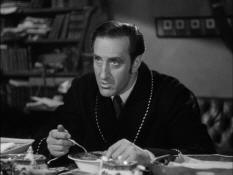
Holmes listens to Watson explain what's happened at Musgrave Manor. |
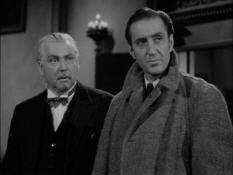
Holmes finds the housekeeper suspicious. |
Thankfully, the mystery in Sherlock Holmes Faces Death has nothing to do
with Nazis, although it is still set in the 1940s. The characters of Holmes and Watson are more in keeping with the way Conan
Doyle wrote them, and that makes this film especially enjoyable for a Holmes fan. Musgrave
Manor is a splendid, spooky old mansion, complete with secret passageways and howling wind
outside. The Musgrave siblings, Geoffrey, Phillip and Sally, have opened their home to
convalescing soldiers. Dr. Watson and Dr. Sexton are also staying at Musgrave Manor,
taking care of the patients.
Holmes comes to the Manor after an attempt is made to kill
Dr. Sexton. Shortly thereafter both Geoffrey and Phillip are murdered. After
Geoffrey's death, Sally must recite the centuries-old ritual, which is meaningless for her.
Holmes realizes that the words in the ritual describe movements of chess pieces, which are
in fact clues to the location of something. Since the black and white floor of the main
hall resembles a chess board, Holmes has the rest of the household move as human chess
pieces. Eventually he finds a crypt in which is hidden an ancient land grant signed by
King Henry. Also in the crypt is the body of the butler. Holmes very cleverly devises a
plan to lure the killer back to the crypt later that evening, and traps him into
confessing all the murders. Holmes then fakes his own death and allows the killer to leave—but he walks right into the hands of Lestrade and half a dozen policemen.
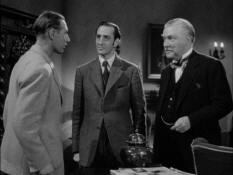
Holmes meets Lt. Clavering |
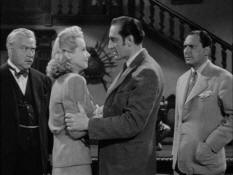
Rathbone assures Sally he will help Vickery. |
Holmes explains to Sally Musgrave that all the killing was because of a
land grant that makes Sally one of the richest women in England. The
killer had planned to marry Sally so that he could share in the wealth.
When Sally learns that declaring ownership of the land would affect
hundreds of people who current live on the land and think that they own
their own land, she says she won't do it, and she throws the land grant in
the fireplace. (Aargh! I hate seeing an historic artifact destroyed. She
could have donated it to a museum ... but of course it wouldn't have had
the same dramatic impact.)
The film ends with Sherlock Holmes and Dr. Watson driving away from
Musgrave Manor. Holmes explains to Dr. Watson that Sally
Musgrave destroyed the ancient land grant because "the old days of grab
and greed are on their way out." But why is Dr. Watson leaving
Musgrave Manor? Don't the convalescent soldiers need him, especially since
Dr. Sexton has been arrested?
"Sherlock Holmes Faces Death" While pic is far
from best of series, it should manage to satisfy the Holmes fans.
Although this one is among the weaker of the Sherlock Holmes films,
it should have little trouble pleasing the admirers of the Sir Arthur
Conan Doyle brain child. Roy William Neill's direction keeps the
action moving smoothly and quickly.
This time Sherlock instead of jousting with enemy agents has the
job of solving a mystery locked within the musty wall of Musgrave
Manor, where dr. Watson and his assistant are looking after a group of
convalescent British soldiers. There are many suspects offered for the
audience's inspection before Sherlock uncovers Dr. Watson's aide as
the guilty party. Some three murders are committed before justice is
done. The cause of all the violence is an ancient land grant belonging
to the owners of the manor. The killer hopes that by eliminating the
male members of the Musgrave household and marrying their sister he'll
come into possession of the extensive lands.
Rathbone gives a standard performance as Sherlock in his latest
appearance in the role. Nigel Bruce's enactment of Watson makes the
film easier to bear. Arthur Margetson is acceptable as the villain.
The girl he seeks to make his wife is played by Hillary Brooke. Among
the other players are Milburn Stone, Halliwell Hobbes, Dennis Hoey,
Gavin Muir, Frederic Worlock.
Neill also acted as associate producer. The screenplay, which is
not always to be taken seriously, is the work of Bertram Millhauser.
DIRECTION, Okay. PHOTOGRAPHY, Good.
—The Film Daily, September 16, 1943, p. 11 |
It may be of interest to note that Captain Vickery, the love interest of Sally
Musgrave, is played by a young Milburn Stone (Doc Adams of "Gunsmoke"
fame). Notice that you never see his feet in this film. Stone was so short
that he had to stand on something when he shared a scene with taller actors.
Stone recalls, "There was this shot where Basil and I had to walk across the
room together. He walked on the floor, but they built a special platform for
me, so I'd look taller. I had a love scene with Hillary Brooke which was
even worse. We were sitting on the sofa and I looked almost like a midget
next to her. The property man supplied me with some pillows to prop me up."
(David Stuart Davies, Starring Sherlock Holmes [London: Titan Books,
2001], p. 50) I didn't see a scene where Stone and Rathbone were walking
together. It must have been cut from the film.
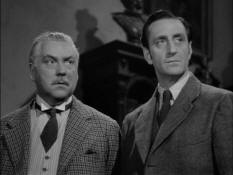
Watson and Holmes listen to the ritual being read. |
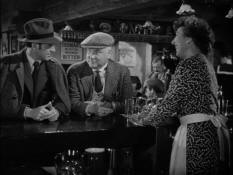
They stop in the local pub and have a pint. |
A
20-year-old Peter Lawford appears in the pub scene at the beginning of the film. He plays
the sailor at the bar who bandages his friend's hand and says "Blimey!" when he
hears about the raven. Lawford later became well-known for being a member of
the Rat Pack (along with Frank Sinatra, Joey Bishop, Dean Martin, and
Sammy Davis Jr.) and John F. Kennedy's brother-in-law.
 A fair "Sherlock Holmes" murder mystery melodrama; it
holds the audience in suspense for not until the closing scenes is the
identity of the murderer made known. The unravelling of the mystery is
far-fetched, but it is in keeping with the amazing talents of
"Holmes," to whom the most baffling murder case is never more than
elementary. The usual tricks have been employed to create an eerie
atmosphere, such as an English manor in a deserted country section, a
storm, and secret doors. As in the other "Sherlock Holmes" pictures
produced by Universal, Basil Rathbone enacts the role of the master
sleuth, and Nigel Bruce plays "Dr. Watson," the detective's blundering
but genial friend:-- A fair "Sherlock Holmes" murder mystery melodrama; it
holds the audience in suspense for not until the closing scenes is the
identity of the murderer made known. The unravelling of the mystery is
far-fetched, but it is in keeping with the amazing talents of
"Holmes," to whom the most baffling murder case is never more than
elementary. The usual tricks have been employed to create an eerie
atmosphere, such as an English manor in a deserted country section, a
storm, and secret doors. As in the other "Sherlock Holmes" pictures
produced by Universal, Basil Rathbone enacts the role of the master
sleuth, and Nigel Bruce plays "Dr. Watson," the detective's blundering
but genial friend:--Summoned to Musgrave Manor, where Geoffrey
Musgrave (Frederick Worlock), head of the house had been murdered,
Sherlock Holmes (Basil Rathbone) and Dr. Watson (Nigel Bruce) learn
that Captain Vickery (Milburn Stone) was suspected of the crime,
because of a lovers' quarrel that had occurred between Sally Musgrave
(Hillary Brooke), the dead man's sister, and himself. Holmes learns
also that the manor was used as a sort of sanitorium for the
rehabilitation of shell-shocked soldiers. Soon after Holmes' arrival,
a mysterious attack is made on Dr. Sexton (Arthur Margetson), a
physician who treated the soldiers. Holmes, during the course of his
investigation, learns from Philip Musgrave (Gavin Muir), the dead
man's brother and new head of the house, of an ancient family ritual
that was observed by each succeeding head of the house upon the death
of his predecessor. Holmes believes this ritual to be the key to the
murder, as well as to a family secret of great value. Philip, too, is
slain mysteriously, and Sally becomes the new head of the manor.
Holmes takes careful notes of Sally's recitation of the ritual and
discovers clues that eventually lead to his discovery of a
subterranean crypt beneath the basement of the manor. There he finds
the family butler (Halliwell Hobbs) murdered, a third victim of the
mysterious killer. To catch the murderer, Holmes sets an ingenious
trap, which leads Dr. Sexton to the crypt and causes him to expose
himself as the triple-slayer. The doctor confesses that he, too, had
solved the riddle of the family ritual, and that, from the solution,
he had learned of ancient land grants that would make the house of
Musgrave one of the richest in England. He had slain both brothers and
the butler to get them out of his way, and had planned to marry Sally.
Bertram Millhauser wrote the screen play, and Roy William Neill
produced and directed it.
Morally suitable for all.
—Harrison's Report, Sept. 4,
1943, p. 142 |
The Musgrave Ritual in Sherlock Holmes Faces Death is different from the
ritual in Arthur Conan Doyle's
story. This is the ritual in the film:
Where was the light on the face of the messenger?
Where did he speed?
To guard the queen's page.
Who to repel?
The King's cautious page.
What then this disaster?
Page slaughters page.
Who came to slay him?
The bloodthirsty bishop.
Where shall he go?
Deep down below.
Away from the thunder,
let him dig under.
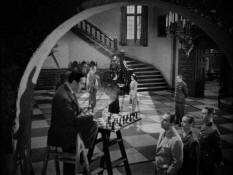
Holmes directs the human "chess pieces." |
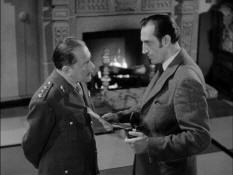
Holmes questions Capt. MacIntosh |
This is the ritual from the story "The Musgrave Ritual":
Whose was it?
His who is gone.
Who shall have it?
He who will come.
Where was the sun?
Over the oak.
Where was the shadow?
Under the elm.
How was it stepped?
North by ten and by ten, east by five and by five, south by two and by two,
west by one and by one, and so under.
What shall we give for it?
All that is ours.
Why should we give it?
For the sake of the trust.
Excellent Sherlock Holmes This is the first of
Universal's new series of Sherlock Holmes detecting stories and it
measures up well with the best of the three turned out last season.
Although it's a modernized version of the Sir Arthur Conan Doyle
stories, it does not deal with Axis spies.
Brought up to date by placing the Doyle story, "Musgrave Manor," in
the period of the present war, with the manor being used for a
convalescent officers' home, the story sticks closely to the Doyle
original.
The master unraveler of baffling crimes is called onto the scene
when Dr. Watson's assistant surgeon at the manor is stabbed in what
appears to be a murder attempt. In true Doyle character, Holmes
arrives with the good doctor just in time to find the manor lord
murdered.
Suspense is built up through the antics of the butler and his wife
and the strange striking of 13 by the tower clock, marking a murder.
Holmes solves the motive for murder through deciphering the strange
Musgrave ritual repeated at the funeral bier of each heir by the
second in line.
Basil Rathbone and Nigel Bruce as the clever Holmes and blundering
Watson turn in exceedingly smooth performances well supported by
Dennis Hoey, the interfering Scotland Yard inspector. Hillary Brooke
and Milburn Stone supply the slight romantic thread.
Producer-director Roy William Neill left nothing to be desired in
suspense, action, and portrayal of the true Holmes and Watson
characters in his direction from a screenplay by Bertram Millhauser,
which adheres very closely to Doyle's story. Photography by Charles
Van Enger was well done, as was the art direction of John B. Goodman
and Harold MacArthur.
Reviewer: Jack Cartwright
—Motion Picture Herald, Sept. 11, 1943, p. 1529 |
Sherlock Holmes Faces Death was the first film in the Universal
series that didn't have the statement at the beginning about Sherlock Holmes
being ageless. Thankfully, Rathbone's hairstyle looks normal again instead
of the bizarre "windswept" look it had in "Sherlock Holmes and the Secret
Weapon, "The Voice of Terror," and "Sherlock Holmes in Washington."
Two of the sets in Sherlock Holmes Faces Death were used in
earlier Universal films. The set for the village (where the pub was
located) was used in the Frankenstein films. The crypt set was built for
film Dracula in 1931. (Tom Weaver, Michael Brunas, and John Brunas,
Universal Horrors: The Studio's Classic Films, 1931-1946 [McFarland
& Co., 2007], p. 356)
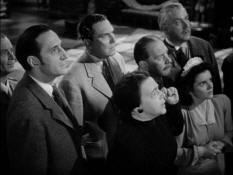
They hear a strange noise, which turns out to be Lestrade trapped
behind the wall. |
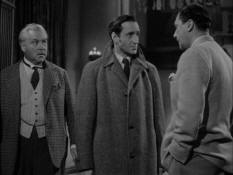
Holmes tells Dr. Sexton to keep an eye on Sally Musgrave. |
"As drawing cards, there are Basil Rathbone and Nigel Bruce giving
expertly smooth accounts of Holmes and the blundering Watson." —Hollywood
Reporter, September 1943
"Basil Rathbone and Nigel Bruce are ideally cast as Sherlock Holmes and
Dr. Watson in this well-constructed detective tale. ... The film is first
class entertainment of its kind." —Motion
Picture Reviews, September 1943
"Mr. Holmes moves with absolutely mathematical precision and the clipped
peremptory tones of Basil Rathbone." —New
York Times, October 8, 1943
"Basil Rathbone and Nigel Bruce, as Holmes and Watson respectively,
contribute their standard performances." —Variety,
September 8, 1943
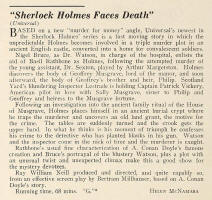 Based on a new "murder for money" angle, Universal's
newest in the Sherlock Holmes' series is a fast moving story in which
the unpredictable Holmes becomes involved in a triple murder plot in
an ancient English castle, converted into a home for convalescent
soldiers. Based on a new "murder for money" angle, Universal's
newest in the Sherlock Holmes' series is a fast moving story in which
the unpredictable Holmes becomes involved in a triple murder plot in
an ancient English castle, converted into a home for convalescent
soldiers.Nigel Bruce, as Dr. Watson, in charge of the hospital,
enlists the aid of Basil Rathbone as Holmes, following the attempted
murder of the young assistant, Dr. Sexton, played by Arthur Margetston.
Holmes discovers the body of Geoffrey Musgrave, lord of the manor, and
soon afterward, the body of Geoffrey's brother and heir, Philip.
Scotland Yard's blundering Inspector Lestrade is holding Captain
Patrick Vickery, American pilot in love with Sally Musgrave, sister to
Philip and Geoffrey and heiress to the Musgrave fortune.
Following an investigation into the ancient family ritual of the
House of Musgrave, Holmes places himself in an ancient burial crypt
where he traps the murderer and uncovers an old land grant, the motive
for the crime. The tables are suddenly turned and the crook gets the
upper hand. In what he thinks is his moment of triumph he confesses
his crime to the detective who has planted blanks in his gun. Watson
and the inspector come in the nick of time and the murderer is caught.
Rathbone's usual fine characterization of A. Conan Doyle's famous
creation and Bruce's portrayal of the blustery Watson, plus a plot
with an unusual twist and unexpected climax make this a good show for
the mystery devotees.
Roy William Neill produced and directed, and quite capably so, from
an effective screen play by Bertram Millhauser, based on A. Conan
Doyle's story.
Helen McNamara
—Motion Picture Daily, Sept. 9, 1943, p. 8 |
When Sherlock Holmes discovers the ancient land grant (or crown grant) in
the Musgrave crypt, he reads the first few words: "Henry, by the Grace of
God, King of Great Britain, France, and Ireland, Defender of the Faith ..."
The document does not specify which King Henry authored it, but the title
"Defender of the Faith" suggests that it was Henry VIII. That title was
first conferred on an English sovereign, Henry VIII, by Pope Leo X on
October 11, 1521. Henry VIII's title was King of England. There was no
official "Kingdom of Great Britain" before the 1707 Act of Union, but James
I nevertheless called himself King of Great Britain, France, and Ireland in
1604. Henry may also have called himself "King of Great Britain,
France, and Ireland." Many English monarchs claimed to also be King of
France even when England no longer held any territories in France.
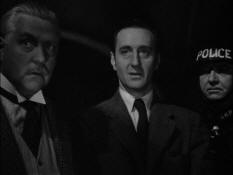
"Did you hear his confession?" asks Holmes. |
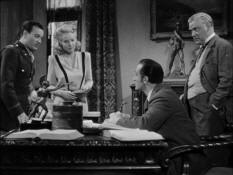
Holmes explains the crown grant to Sally Musgrave. |
Hillary Brooke told the authors of Universal Horrors that working
on the Sherlock Holmes films at Universal was delightful. She said, "Nigel
Bruce became a dear friend and Basil was a darling. We both loved animals
and ice cream. When we were not working, we would get ice cream cones and
stroll to the back of the lot to see and visit with the animals." (Universal
Horrors, p. 356)
See Page
Two for screenshots from the film. See Page
Three for pictures of posters, lobby cards and promo photos.
..
|
Cast |
|
| Basil Rathbone
... |
Sherlock Holmes |
|
Nigel Bruce ... |
Dr. Watson |
| Dennis Hoey ... |
Inspector Lestrade |
| Arthur Margetson ... |
Dr. Sexton |
|
Hillary Brooke ... |
Sally Musgrave |
|
Halliwell Hobbes ... |
Brunton |
|
Minna Phillips ... |
Mrs. Howells |
|
Milburn Stone ... |
Capt. Vickery |
|
Gavin Muir ... |
Phillip Musgrave |
|
Gerald Hamer ... |
Maj. Langford |
|
Vernon Downing ... |
Lt. Clavering |
|
Olaf Hytten... |
Capt. MacIntosh |
|
Mary Gordon ... |
Mrs. Hudson |
|
Joan Blair ... |
Nora (maid) |
|
Heather Wilde... |
Jenny (maid) |
|
Frederic Worlock... |
Geoffrey Musgrave |
|
Peter Lawford ... |
sailor at bar |
|
Harold de Becker ... |
Pub Proprietor |
|
Norma Varden ... |
Gracie (barmaid) |
| |
|
|
|
|
Credits |
|
| Production
Company ... |
Universal |
| Producer
... |
Roy William Neill |
|
Director ... |
Roy William Neill |
|
Screenplay ... |
Bertram Millhauser |
| Cinematographer
...
|
Charles Van Enger |
| Film Editing
... |
Fred R. Feitshans, Jr. |
|
Music Director ... |
H.J. Salter |
| Art Directors
... |
John B. Goodman, Harold MacArthur |
|
Set Decorators ... |
Russell A. Gausman, E.R. Robinson |
| Asst. Director
... |
Melville Shyer |
| Sound
Director
... |
Bernard B. Brown |
|
Sound Technicians ... |
Paul Neal, Edwin Wetzel |
|
Costumes ... |
Vera West |
| |
|
|
|
.
|
























